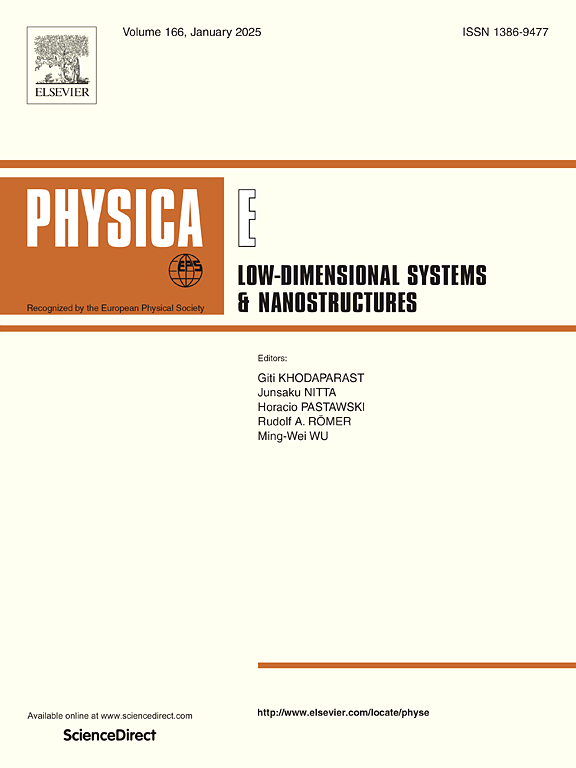基于多层纳米阵列的光热转换超宽带太阳能吸收器
IF 2.9
3区 物理与天体物理
Q3 NANOSCIENCE & NANOTECHNOLOGY
Physica E-low-dimensional Systems & Nanostructures
Pub Date : 2024-10-05
DOI:10.1016/j.physe.2024.116123
引用次数: 0
摘要
在这项工作中,我们基于有限差分时域法,提出并研究了一种基于多层纳米环的高效纳米级太阳能吸收器。该吸收器由 4 层 TiO2-TiN 纳米环阵列、TiO2 绝缘层和 Ti 衬底组成,所有材料均为高熔点材料。该吸收器在 280-4000 纳米波长范围内的吸收效率超过 95%,从而达到 3720 纳米的带宽。此外,它在整个波长范围内的平均吸收效率为 98.8%。此外,计算显示,该吸收器的太阳光谱加权吸收率高达 99%。对电场分布的分析表明,观察到的高吸收率可归因于质子共振现象以及多圈纳米环表现出的近场耦合效应。此外,我们的计算还表明,这种吸收器的热辐射效率非常高,在 2000 K 和 1500 K 时分别达到 99.2% 和 98.9%。因此,我们接着计算了该吸收器的光热转换效率。当太阳浓度系数 C = 1000 时,光热转换效率在整个温度范围内均超过 90%。在 C = 100 时,1000 K 时的光热转换效率仍大于 80%;在 C = 10 时,700 K 时的光热转换效率仍大于 80%;在 C = 1 时,500 K 时的光热转换效率仍大于 80%。此外,这种吸收器还能在更宽的太阳辐射角度下保持其卓越的吸收能力,显示出对偏振变化不敏感的特性以及对制造误差的强大耐受力。这些优异的特性使其非常适合于太阳能收集和光热转换领域的各种应用。本文章由计算机程序翻译,如有差异,请以英文原文为准。

Multi-layer nanoring array-based ultra-wideband solar absorber for photothermal conversion
In this work, based on the finite difference time domain method, we propose and investigate an efficient nanoscale solar absorber based on multilayer nanorings. The absorber is made up of a 4-layer TiO2-TiN nanoring array, a TiO2 insulating layer and a Ti substrate, all of which are high-melting materials. The absorber exhibits an absorption efficiency surpassing 95 % across a wavelength span of 280–4000 nm, thereby attaining a bandwidth of 3720 nm. Additionally, it maintains an average absorption efficiency of 98.8 % throughout the entire wavelength spectrum. Furthermore, calculations reveal that the absorber possesses a solar spectrum-weighted absorption of up to 99 %. The analysis of the electric field distribution indicates that the observed intense absorption is attributed to the plasmonic resonance phenomenon, along with the near-field coupling effects exhibited by the multi-turn nanorings. In addition, our calculations revealed a remarkably high thermal radiation efficiency for this absorber, specifically 99.2 % at 2000 K and 98.9 % at 1500 K, respectively. Therefore, we then calculated the photothermal conversion efficiency of the absorber. At the solar concentration factor C = 1000, the photothermal conversion efficiency surpasses 90 % across the entire temperature range. At C = 100, it is still greater than 80 % at 1000 K. At C = 10, it is still greater than 80 % at 700 K. And at C = 1, it is still greater than 80 % at 500 K. These results indicate that absorbers can be used in a variety of environments. Furthermore, the absorber sustains its superior absorption capabilities at wider solar radiation angles, demonstrating insensitive properties to polarization variations and robust tolerance to manufacturing inaccuracies. These exceptional attributes render it highly suited for diverse applications in solar energy harvesting and photothermal transformation.
求助全文
通过发布文献求助,成功后即可免费获取论文全文。
去求助
来源期刊
CiteScore
7.30
自引率
6.10%
发文量
356
审稿时长
65 days
期刊介绍:
Physica E: Low-dimensional systems and nanostructures contains papers and invited review articles on the fundamental and applied aspects of physics in low-dimensional electron systems, in semiconductor heterostructures, oxide interfaces, quantum wells and superlattices, quantum wires and dots, novel quantum states of matter such as topological insulators, and Weyl semimetals.
Both theoretical and experimental contributions are invited. Topics suitable for publication in this journal include spin related phenomena, optical and transport properties, many-body effects, integer and fractional quantum Hall effects, quantum spin Hall effect, single electron effects and devices, Majorana fermions, and other novel phenomena.
Keywords:
• topological insulators/superconductors, majorana fermions, Wyel semimetals;
• quantum and neuromorphic computing/quantum information physics and devices based on low dimensional systems;
• layered superconductivity, low dimensional systems with superconducting proximity effect;
• 2D materials such as transition metal dichalcogenides;
• oxide heterostructures including ZnO, SrTiO3 etc;
• carbon nanostructures (graphene, carbon nanotubes, diamond NV center, etc.)
• quantum wells and superlattices;
• quantum Hall effect, quantum spin Hall effect, quantum anomalous Hall effect;
• optical- and phonons-related phenomena;
• magnetic-semiconductor structures;
• charge/spin-, magnon-, skyrmion-, Cooper pair- and majorana fermion- transport and tunneling;
• ultra-fast nonlinear optical phenomena;
• novel devices and applications (such as high performance sensor, solar cell, etc);
• novel growth and fabrication techniques for nanostructures

 求助内容:
求助内容: 应助结果提醒方式:
应助结果提醒方式:


